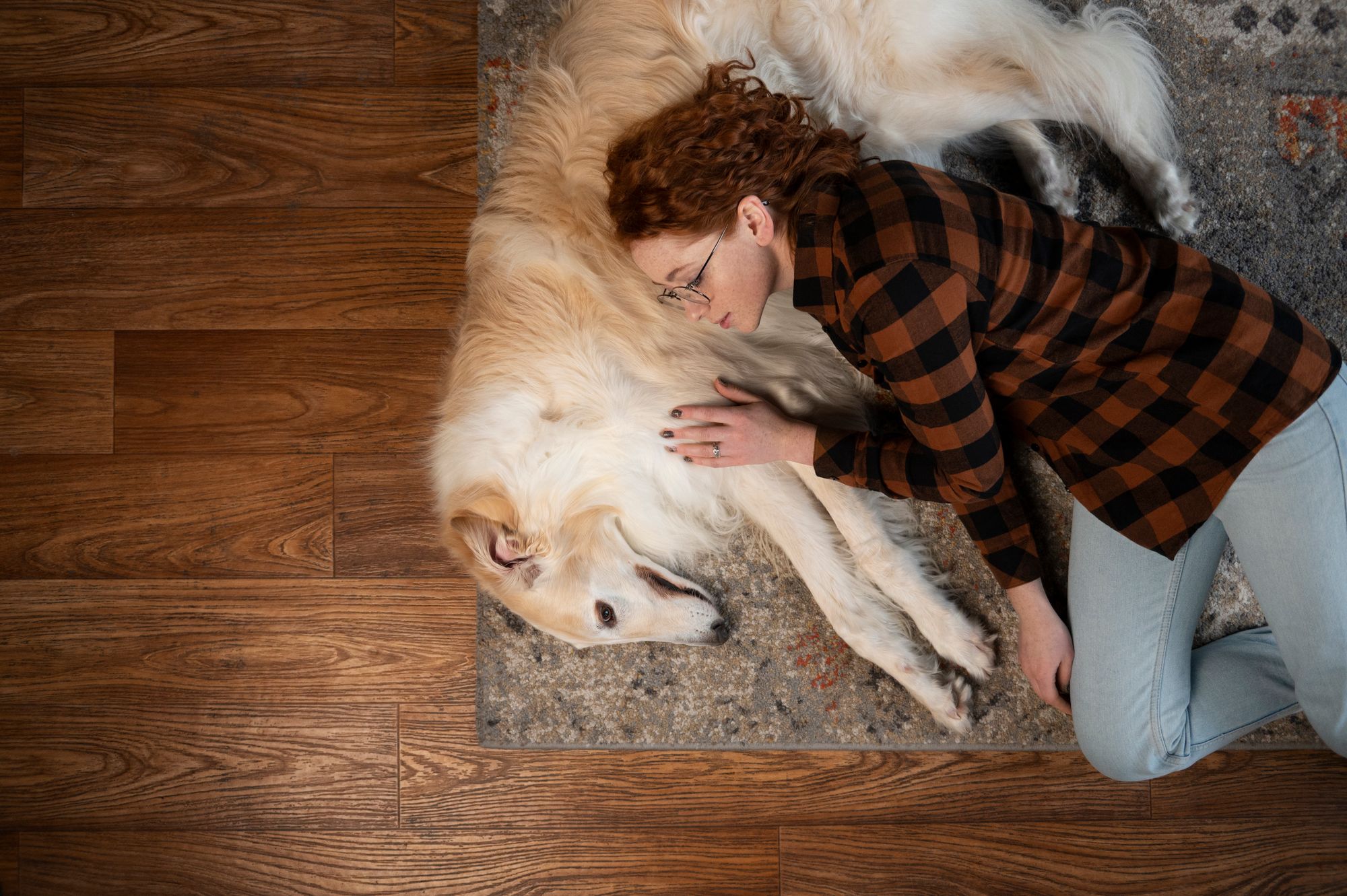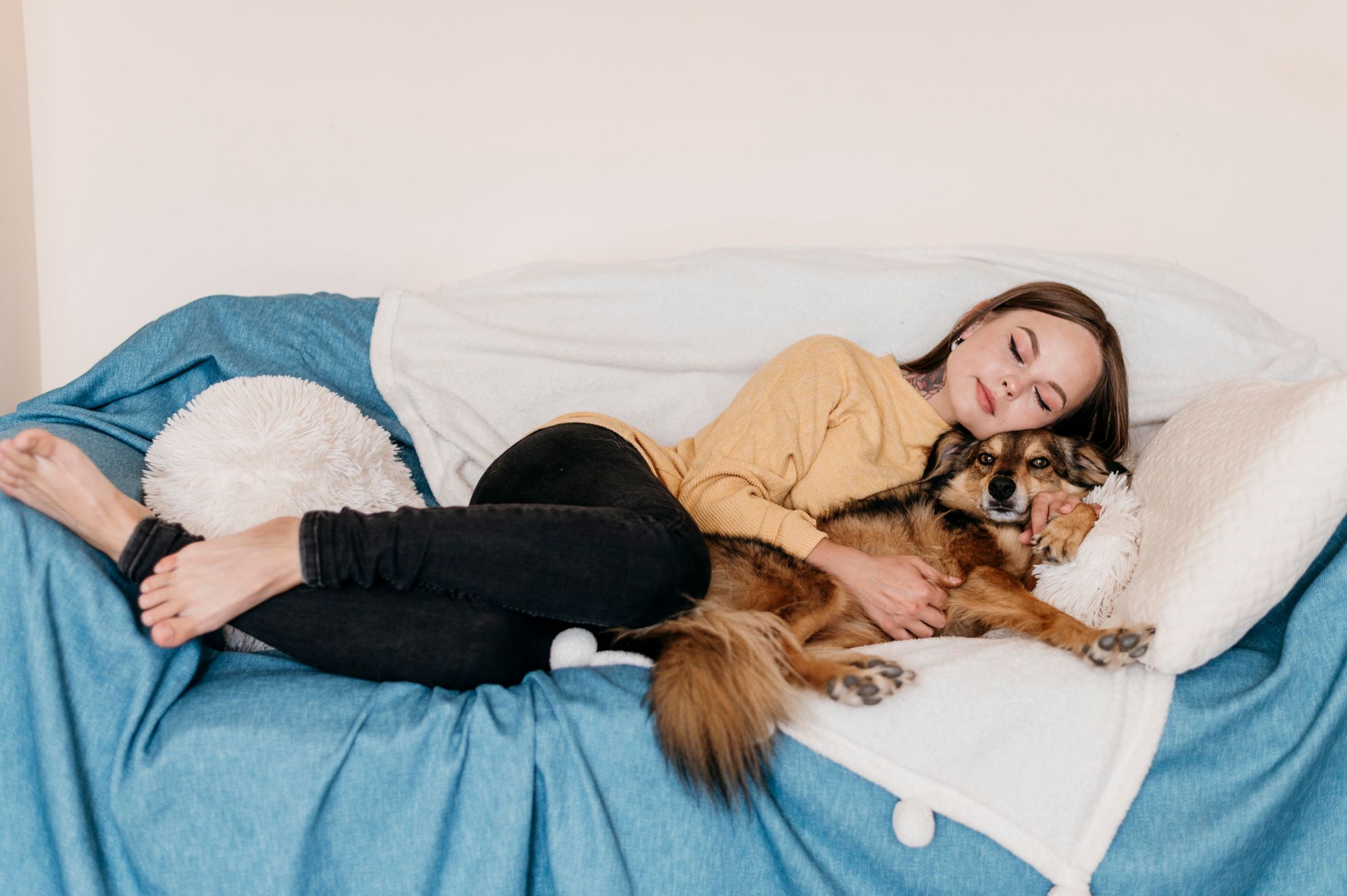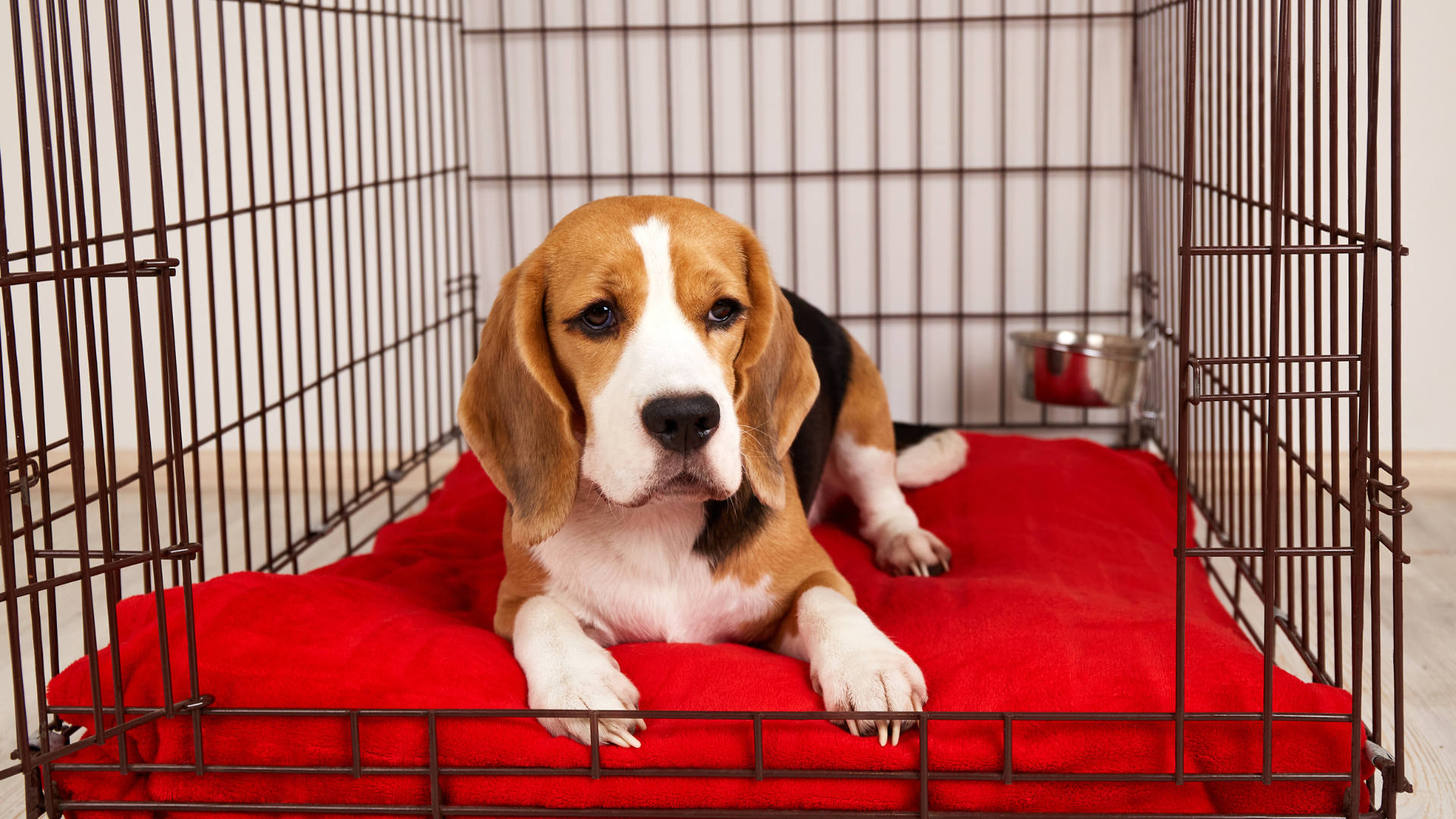
Just as humans have their preferred sleeping positions, dogs also have their unique ways of sleeping. But have you ever wondered about the significance behind your furry friend's chosen sleeping position when they sleep with you? In this article, we will delve into the world of dog sleeping positions with owner, unveiling the meanings and advantages they hold for both dogs and their human companions.
From spooning to leaning against, belly up to nestling, and nearby presence, each position tells a story and deepens the bond between you and your canine companion. So, if you're curious about why your dog snuggles up to you in a particular manner, join us on this captivating exploration of dog sleeping positions.
The Cuddle Buddy: Spooning Sleeping Position
One of the most beloved and frequently observed dog sleeping positions with owners is spooning. When dogs spoon with their owners, they curl up and nestle against their owner's body, aligning their back with the owner's side. This position fosters a profound sense of intimacy, closeness, and comfort between the dog and their human companion. As the dog snuggles up against their owner, they create a physical bond that symbolizes trust, love, and a desire for emotional connection. Spooning provides a warm and secure environment for both the dog and the owner, promoting a deep sense of relaxation and contentment. It is a beautiful display of the strong emotional connection that can develop between dogs and their loving owners during peaceful moments of shared sleep.
Why Do Dogs Spoon?
Dogs often choose to spoon with their owners for several reasons, primarily to feel a sense of safety and security. When dogs engage in spooning, the physical contact triggers the release of oxytocin, a hormone closely linked to bonding and relaxation. This surge of oxytocin fosters a profound sense of trust and affection between the dog and their owner. Spooning is especially prevalent among smaller breeds or dogs that naturally exhibit higher levels of anxiety or are prone to separation anxiety. By snuggling up closely and aligning their bodies with their owners, dogs find solace in the presence of their trusted human companion. The act of spooning not only provides comfort and reassurance but also creates an environment conducive to emotional well-being and a deepened bond between dogs and their owners.
What are the Benefits of Spooning for Dogs?
When it comes to dog sleeping positions with their owners, spooning offers a range of benefits for our furry friends. Here are the key advantages of spooning:
- Emotional Bonding: Spooning fosters a stronger emotional bond between dogs and their owners. Physical closeness and contact promote feelings of security, trust, and love, deepening the connection between them.
- Increased Body Warmth: By snuggling up in a spooning position, dogs can take advantage of their owner's body heat. This warmth provides additional comfort, especially during colder nights or in chilly environments. Anxiety Relief: Dogs prone to anxiety or separation anxiety can find solace in spooning. Close physical contact and the reassurance of their owner's presence can help reduce stress levels and create a calming atmosphere for the dog.
Spooning is not only a cozy sleeping position but also a means to strengthen the emotional bond, provide warmth, and alleviate anxiety in dogs who choose to sleep in this manner with their owners.

II. The Protective Huddle: Leaning Against Sleeping Position
Dogs often adopt the leaning against position when sleeping next to their owners. In this position, the dog rests their body against their owner's legs or gently leans against their side.
The Meaning Behind Leaning Against
Explanation: Leaning against their owners is a way for dogs to seek comfort, protection, and security. By physically relying on their owners, dogs demonstrate their trust and their desire to be close to their beloved humans.
Advantages of Leaning Against Sleeping Position
- Mutual Comfort: Both the dog and the owner benefit from the closeness and warmth provided by the leaning against position. It promotes a sense of relaxation, contentment, and a feeling of unity between the dog and the owner.
- Protection and Security: The physical contact during leaning against reassures dogs that their owners are present, creating a feeling of protection. This can help alleviate anxiety and make the dog feel safe and secure.
- Physical Support: Leaning against their owners can provide additional support and alleviate discomfort, particularly for older dogs or those with joint or muscle issues. The owner's body acts as a comforting and supportive surface for the dog to lean against.
III. The Lap Warmer: Belly Up
When dogs sleep belly up next to their owners, it means they are lying on their back with their belly exposed. It is a vulnerable position that demonstrates trust and relaxation.
The Significance of Belly Up
Explanation: By exposing their belly, dogs in the belly-up position showcase their complete trust in their owners. This position indicates that the dog feels safe, comfortable, and at ease in their environment, and enjoys the company of their human companion.
Benefits of the Belly Up Sleeping Position
- Deep Relaxation: Sleeping belly up allows dogs to enter a state of deep relaxation. It signifies that they feel secure and at ease with their surroundings, enabling them to let their guard down and fully unwind during sleep.
- Easy Belly Rubs: For owners, the belly-up position provides the perfect opportunity to give their furry friends a gentle belly rub. Many dogs enjoy having their belly rubbed, and it can be a soothing and pleasurable experience for them.
- Enhanced Bonding: Trust and comfort are essential for building a strong bond between dogs and their owners. The belly-up position facilitates this process by creating an environment of safety and relaxation, fostering a deeper connection and strengthening the bond between the dog and their owner.
IV. The Snuggle Bug: Nestling
Nestling is a dog sleeping position where the dog curls up and snuggles closely against their owner. They may tuck their head or muzzle under their owner's arm or against their chest for added security.
The Coziness of Nestling Sleeping Position
Explanation: Nestling provides a sense of intimacy, warmth, and comfort for both dogs and their owners. It allows dogs to feel protected, loved, and in close proximity to their favorite humans.
Benefits of Nestling Sleeping Position
- Bond Strengthening: Nestling promotes a stronger emotional bond between dogs and their owners. The physical closeness and contact create a feeling of unity, affection, and shared warmth, deepening the bond and strengthening the relationship.
- Stress Relief: The act of nestling against their owner can help dogs relax and reduce anxiety. The familiar scent and touch of their human companion have a soothing effect on their nervous system, providing a comforting environment that eases stress and promotes a sense of calm.
- Comfortable Sleep: Dogs who nestle against their owners often experience a more restful sleep. The feeling of security and warmth provided by nestling contributes to a comfortable sleeping environment, allowing dogs to achieve a deeper and more rejuvenating sleep cycle.
V. The Independent Doze: Nearby Presence
Some dogs prefer to maintain a bit of distance while still choosing to sleep near their owners. They may find a spot close by, such as a dog bed or a nearby couch, where they can observe their owner while maintaining their own space.

The Significance of Nearby Presence Sleeping Position
Dogs adopting the nearby presence position value their independence and personal space. They want to be in close proximity to their owners, feeling connected and protected while having the freedom to move around and maintain their own comfortable sleeping area.

Advantages of Nearby Presence Sleeping Position
- Individual Comfort: Dogs that prefer nearby presence enjoy having their own space to stretch out, change positions, and regulate their body temperature without disturbing their owners. It allows them to find their preferred sleeping position and ensures their physical comfort during sleep.
- Observational Security: By positioning themselves nearby, dogs can keep an eye on their owners, ensuring their safety while maintaining a sense of vigilance and protection. This position allows them to be alert to any potential threats or changes in their environment.
- Quality Rest: With their personal space respected, dogs can enjoy uninterrupted sleep. The nearby presence position provides the opportunity for dogs to have a peaceful and rejuvenating rest, promoting overall well-being and energy levels.
Conclusion:
Understanding the sleeping positions dogs adopt with their owners provides insights into their behavior, emotions, and needs. From spooning to leaning, belly up to nestling, and nearby presence, each position benefits dogs and their owners. Spooning strengthens emotional bonds, offers warmth, and relieves anxiety. Leaning signifies comfort, protection, and support for dogs with joint issues. Belly-up shows trust, relaxation, and fosters a bond. Nestling provides intimacy, stress relief, and a cozy sleep environment. Nearby presence respects independence while maintaining closeness for comfort and security. Respecting these positions fosters a bond, provides security, and contributes to well-being. Remember each dog is unique, so observe and accommodate their preferences for a peaceful sleep experience.
FAQs About Dog Sleeping Positions with Owner
Why do dogs prefer to sleep next to their owners?
A: Dogs are pack animals by nature, and sleeping next to their owners provides them with a sense of security, companionship, and warmth. It strengthens the bond between the dog and their owner and can help alleviate separation anxiety.
Q: Are certain dog breeds more likely to spoon or lean against their owners?
A: While individual preferences can vary, smaller breeds and dogs that are more prone to anxiety or seek comfort tend to be more inclined to spoon or lean against their owners. However, it's important to remember that each dog is unique, and their preferences can vary regardless of breed.
Q: Should I allow my dog to sleep in my bed?
A: Whether or not to allow your dog to sleep in your bed is a personal decision. It depends on your comfort level, the size of your dog, and any specific concerns you may have, such as allergies or disruptive sleep patterns. Providing your dog with a comfortable alternative, such as a nearby dog bed, can also be a good compromise.
Q: Can dog sleeping positions indicate their emotional state?
A: Yes, dog sleeping positions can provide insights into their emotional state. For example, dogs that sleep in belly-up positions demonstrate a high level of trust and relaxation, while dogs that prefer to sleep in nearby presence positions may desire a balance between independence and closeness.
Q: Is it normal for dogs to change their preferred sleeping position over time?
A: Yes, it is normal for dogs to change their sleeping positions over time. Factors such as age, health conditions, weather, and changes in their environment or routine can influence their sleeping preferences. Pay attention to your dog's comfort and adjust their sleeping arrangements accordingly.
Q: What should I do if my dog shows signs of discomfort or restlessness during sleep?
A: If your dog displays signs of discomfort or restlessness during sleep, such as excessive movement, whining, or difficulty settling down, it's important to assess the possible causes. Check for any physical discomfort, ensure their sleeping area is comfortable and free from distractions, and consult with a veterinarian if you have concerns about their sleep patterns.
Q: How can I create a conducive sleeping environment for my dog?
A: To create a conducive sleeping environment for your dog, provide them with a comfortable and appropriately sized bed or sleeping area. Keep the area clean, quiet, and free from excessive noise or disturbances. Consider factors such as temperature and lighting to ensure your dog's comfort during sleep.
Q: Should I establish a consistent bedtime routine for my dog?
A: Yes, establishing a consistent bedtime routine can be beneficial for dogs. It helps them associate specific cues with sleep, such as going for a walk, providing a meal, and settling down in their designated sleeping area. A consistent routine can promote relaxation and better sleep for your dog.
Q: Are there any specific considerations for older or senior dogs' sleeping positions?
A: Older or senior dogs may have specific comfort needs, such as orthopedic support or relief for joint stiffness. Providing a supportive and comfortable bed, ensuring easy access to their sleeping area, and considering their specific health conditions can help older dogs sleep more comfortably.
Q: Can I train my dog to sleep in a specific position?
A: While you can encourage your dog to sleep in a certain position, their natural preferences and comfort should be respected. Focus on providing a comfortable sleeping environment, reinforcing positive associations with their sleeping area, and allowing your dog to choose the position that feels most comfortable for them.

